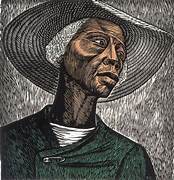A few years ago, I had the pleasure of watching a YouTube documentary on black art and the lack thereof in the global community. As the host of the documentary spanned different segments and spoke of different artists, there was this one part that showed this ever-so-quiet person with lowered eyes and an even lower voice. The volume of her voice seemed to be held back from underneath a multicolored hat fitted to her head. When she did decide to speak, that same quiet voice became as loud as the roar of a lion. That person was Dr. Samella Lewis. What struck my fancy was her ability to shape-shift from artist to curator, educator, art activist, mentor, and founder, and then shift back to artist again. With the support of other like-minded fellow community leaders, a group of art visionaries, and Dr. Lewis herself, the MAAA Museum of African American Art, a non-profit 50(c)(3) organization, opened its doors in 1976. Lewis passed away on May 27th, 2022. Samella, the artist, painted extraordinary images full of vivid colors and strong themes with imaginative stories wrapped around her experiences in global travel and meeting like-minded people from a variety of cultures and lifestyles. An author and mentor to other artists, Dr. Samella Lewis, left some awfully big shoes to fill, made by feet that have walked in many directions, that direction led to a final destination called the MAAA. The museum is located in the Baldwin Hills Crenshaw Plaza in Los Angeles, California. The enriched and deeply profound history of MAAA and the legacy of Dr. Lewis are instilled in the likes of the museum’s director, Keasha Dumas Heath. Keasha is fortunate enough to have known and become influenced by Dr. Lewis, feel her spirit, and keep the legacy of her work going. The MAAA stands seriously in place for the spirits, hearts, and souls of those who have walked through its doors and left behind the ancient treasures of their knowledge of history, wisdom, and the importance of culture. An internationally recognized artist, Dr. Lewis served as director of the MAAA for ten years, intending to educate all visitors of all ages and identities about the arts from the perspective of African Americans.



The museum’s programs and exhibits allow local artists of color to have their work presented in a way that directly connects a common network of artistic and visual language that can be interpreted by furthering the reach of global communities throughout the African diaspora. The MAAA is designed as a creative space for artists to feel safe and encouraged and to extend their work in a meaningful way to the public. With free admission, the museum draws many people and has become a go-to place to further promote the healthy advancement of the richness in the history of African American arts and culture.
Presently, MAAA is showcasing the artistic works of artists who live along Line K of the Metro, called “Arts and Culture, “Along the K.”. Line K serves the neighborhoods of Crenshaw, West Adams, Jefferson Park, Baldwin Hills, Leimert Park, Hyde Park, Inglewood, Ladera Heights, Westchester, and others. Due to popular demand, the exhibition has been extended until May 2024. Additionally, the artist Palmer C. Hayden’s 12 series of art narratives on the life and story of the Ballad of John Henry. The collection also sheds light on why America’s most outstanding artist of the Harlem Renaissance is getting a workover and is a permanent part of the museum’s collection. The collection houses masks, carvings, batiks, and paintings, as well as ceremonial objects taken from the countries of South America, Africa, the South Pacific, the Caribbean, and the US.

The hours of the MAAA are from Wednesday through Sunday, 11 a.m.–5 PM, and they are located at 650 W. Martin Luther Kings Jr. Blvd., Suite 282, Los Angeles, CA 90008. For more information on MAAA, go to www.maaala.org.